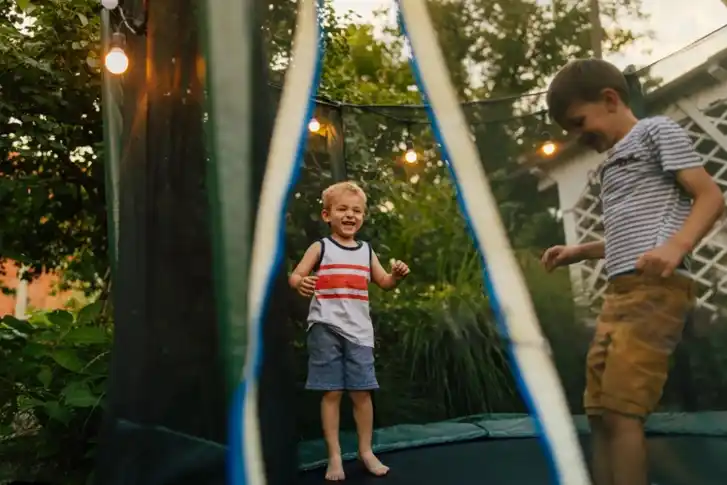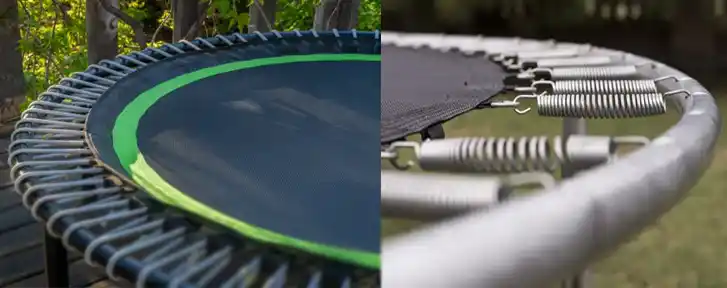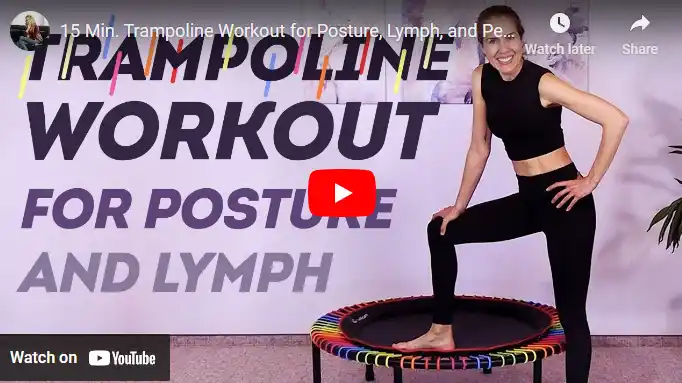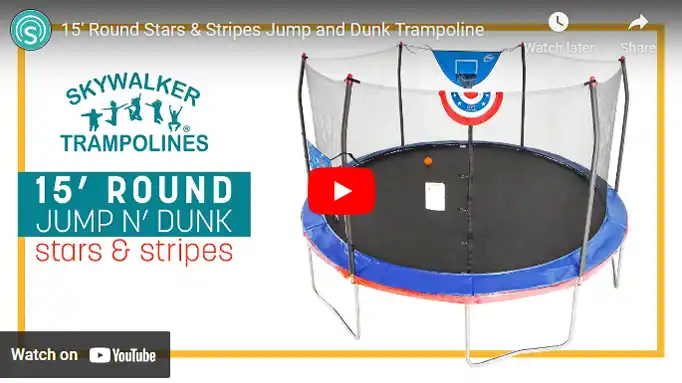Rebounder vs. Trampoline: What Is the Difference?
Disclaimer: This website exists thanks to you, the readers. When you buy through links on my site, I may earn an affiliate commission.
Rebounders vs. trampolines… Is there even a difference?
These two might look like they belong to the same family, but they each have their own unique quirks! Whether you’re searching for a fun way to get fit or an awesome backyard activity for everyone, it’s worth knowing what each one brings to the table.
This article will help you understand the key differences between rebounders and trampolines so you can make the right choice for your needs.
Let’s dive in!
Key Takeaways
- Rebounders are smaller and designed mainly for fitness exercises. Trampolines are generally larger and used for recreation and acrobatics.
- Trampolines often come with safety nets and are meant for outdoor use. Most people use their rebounders indoors. But this doesn’t mean you can’t rebound in your backyard!
- Trampolines require more space and are harder to move. Rebounders are portable and easy to store. Many of them fold, too.
- Both devices offer the same health benefits. Getting one or the other depends on what you want to achieve. Are you looking to get fit? Do you want an energy outlet for your toddler? Are you looking for a fun way to get your teenager to move?
Understanding the Basics: Rebounder vs. Trampoline
Alright, let's dive into the basics of rebounders and trampolines. These two might seem similar at first glance, but they have some key differences that set them apart.
What is a Rebounder?
A rebounder, often called a mini trampoline, is a small, sturdy piece of equipment designed primarily for fitness and exercise. It's compact and usually found indoors. People love using rebounders for low-impact workouts that are easy on the joints. If you're looking for a way to get fit without putting too much strain on your body, a rebounder might be just what you need.
For example, here is a rebounding workout by Dr. Bri's Vibrant Pelvic Health:
What is a trampoline?
Trampolines, on the other hand, are larger and often used for… well, just fun! They come in various sizes — from small indoor versions to large backyard setups. Trampolines are great for high-intensity workouts, tricks, and acrobatics.
Caution! Do not attempt any stunts or let your kid do them if you lack the proper training and experience. Between 47 and 99% of trampoline injuries occur from people performing somersaults, flips, and other risky maneuvers.
Like rebounders, trampolines offer a fun way to get some exercise, but they do require more space and often come with higher safety considerations. For example, you should never let more than two people jump on a trampoline (as fun as it might look!). The American Association strongly discourages it.
Here is a fun video of kids playing on a Skywalker outdoor trampoline:
Feature | Rebounder | Trampoline |
|---|---|---|
Size | Small (3-4 feet in diameter) | Large (6-16+ feet in diameter) |
Primary Use | Fitness and exercise | Recreation and acrobatics |
Location | Indoors (can be used outdoors) | Outdoors (can be used indoors) |
Portability | Highly portable, easy to store | Less portable, often staked to the ground |
Safety Features | Non-slip surfaces, handlebars, safety pads | Safety nets, padded edges, safety pads |
Suitable for Kids | Generally not, except specific toddler versions | Yes, suitable for older kids and adults |
Exercise Type | Low-impact workouts | Low-impact workouts, fun activities |
Fun Factor | More of a single-person activity | Great for family and group fun |
Material and build | Durable, designed for repetitive exercises | Durable, designed to withstand outdoor conditions |
Initial Investment | $50 - $700 | $300 - $2000+ |
Maintenance | Rarely needed | Regular maintenance required |
Maintenance Costs | Low, occasional bungee or spring replacement | Higher, regular checks for springs, mat, and net |
Long-term Value | Great for fitness, indoor use | Versatile, great for outdoor fun and fitness |
Injury risks | Low, easy to fall off if space is limited | Higher, especially without proper precautions |
Storage | Compact, often foldable | Requires more space, not easily stored |
Rebounder vs. trampoline: In-depth review
Dimensions and structure
When it comes to size, trampolines and rebounders are quite different. Trampolines are generally much larger, with diameters ranging from 6 feet to 16 feet or more. They are often used in backyards or trampoline parks.
Rebounders are much smaller in size and more compact, usually around 3 to 4 feet in diameter, making them perfect for indoor use.
Material and build quality
Good-quality trampoline and rebounders are both made of high-quality durable materials like stainless steel. Trampolines are optimized to be able to survive harsh outdoor conditions and multiple users. Rebounders are designed to handle repetitive exercises and are thought to provide better lymphatic drainage.
Safety features
Safety is a key consideration for both trampolines and rebounders. Trampolines often come with safety nets and padded edges to prevent injuries because people, especially kids, do free jumps on them. Rebounders usually have non-slip surfaces and handlebars.
Suitable for kids
Now that’s a very complex question. Generally speaking, some rebounders (very few) also double as toddler trampolines. But I think that’s a bit of a questionable feature.
Rebounders are designed for adult fitness. This means the mat is generally tighter compared to small children’s trampolines like Little Tikes. The weight limit on children’s trampolines is generally lower, too. This means that they would not be suitable for adults to jump on.
In most cases, rebounders are only for adults. There is another category of trampolines for small children.
Large trampolines, on the other hand, can be used by grown kids (usually 10+) and adults alike. As long as you’re within the weight limit, you’re good.
Fitness and exercise
When it comes to fitness, both rebounders and trampolines can help you exercise.
Rebounders, though, are fantastic for low-impact workouts. They are gentle on the joints, making them perfect for people who need a softer landing. You can use them for various exercises like jogging in place, jumping jacks, or even dance routines.
The same applies to trampolines, more or less. You might not get the same workout on a large trampoline, but if you have kids and you want to kill two birds with one stone, a trampoline might be your go-to. It can help the kids spend more time outdoors, and you can also get some exercise on it.
Having fun
To most people, trampolines are a fun thing to do in the backyard. Both kids and adults can spend hours bouncing around and playing games. They are a hit at parties and family gatherings.

You can’t exactly say the same about rebounders. They are definitely a fun way to get exercise, but they are more of a single-person activity. For example, you can have a bouncing session on your rebounder while watching TV or listening to music. But it’s unlikely to turn into the entire family’s favorite thing to do.
Portability and storage
It goes without saying that, when it comes to portability and storage, rebounders and trampolines are completely different.
Rebounders are compact and lightweight. They are easy to move around and store. Some of them are foldable and you can take them to the fitness or when traveling.
Trampolines are big, heavy, and they are simply not meant to be moved around a lot. In fact, most home trampolines are pinned to the ground with trampoline stakes (link to Amazon). They are designed to stay in one location like a backyard.
Initial investment
When it comes to the initial investment, trampolines and rebounders can vary widely in price.
A basic rebounder might cost you around $50 to $100, while high-end models can go up to $700. On the other hand, trampolines, especially the larger ones, can range from $300 to over $2,000.
Maintenance costs
Maintenance costs are another factor to think about. Both rebounders and trampolines need upkeep. The cost depends on what you need to repair.
For trampolines, you will need to replace the mat, springs or bungees, and safety net over time. This is because they are subject to the forces of nature and the jumping force is typically bigger compared to rebounders.
Rebounders, on the other hand, rarely if ever, need maintenance. The most vulnerable thing is the bungees if it’s a bungee rebounder. That’s a type of elastic cord that holds the mat to the frame and makes the rebounder bouncy. There are also spring-based rebounders that use steel springs. Both have their benefits and drawbacks. You can read more about spring vs. bungee rebounders here.

In the rare cases when you do need to buy a spare part for a rebounder, that’s generally cheaper because it’s simply smaller in size. For example, a good-quality safety pad, like this one from SkyBound (Amazon link), will cost you about $90. If you ever need a new safety pad for your rebounder (Amazon link), that will be about $20.
Rebounders, being smaller and simpler, usually have fewer parts that can wear out. They are also much, much cheaper. So, it doesn’t make a lot of sense for manufacturers to offer spare parts for something that doesn’t cost a lot.
Long-term value
In terms of long-term value, both options have their perks. Rebounders are great for indoor use and can be a fantastic addition to your fitness routine. Because you don’t have to repair them often, they are good value for money in most cases.
Trampolines, although not great for fitness, are more versatile. When you take good care of them, repair them regularly, and cover them in winter, they will last a long time.
When deciding between a rebounder and a trampoline, think about your long-term goals and how each option fits into your lifestyle. This will help you make a more informed decision and get the best value for your money.
Injury risks
When it comes to using trampolines, collisions are a concern. To avoid accidents, always be aware of your surroundings and steer clear of risky or overly challenging routines.
Rebounders are smaller, which might make it easier to fall off or bump into things. So, make sure you have enough room and good lighting before you start bouncing.
As to large trampolines, I will repeat this: Never let more than one person jump.
Safety Accessories
Using the right safety accessories can make a big difference. For trampolines, safety nets and padding are a must.
For rebounders, avoid relying too much on handlebars as they can lead to bad habits like incorrect posture. Instead, focus on getting comfortable with the movement first.
With both rebounders and trampolines, always ensure your equipment is in good condition and regularly check for wear and tear.
Rebounder vs. trampoline: Which one should you get?
Well, there isn’t a lot to choose. The reality is that these are simply different pieces of equipment.
Rebounders are meant for adult fitness. Trampolines are a fun way for kids and adults to get outside and move. You decide which one is a priority for you. Or maybe you want to get both.
The best rebounders: Comparison table
Product | My Rating | Verdict | Price |
|---|---|---|---|
This rebounder's innovative spring technology offers a unique, adaptable rebounding experience that boosts full-body strength. | |||
This compact mini trampoline is a quiet, stable, and space-saving option that offers exceptional value for its price. | |||
This rebounder is an excellent choice for those looking for a durable, quiet, and safe option for regular workouts, offering great value for its features. |
The best outdoor trampolines: Comparison table
Product | My Rating | Verdict | Price |
|---|---|---|---|
The Skywalker Trampoline combines top-notch safety features, a spacious jump mat, and a basketball hoop, offering durable, family-friendly fun for kids and adults alike. | |||
The Zupapa Trampoline offers exceptional safety with its no-gap design, durable frame, and extended net poles, ensuring a secure and stable jumping experience. | |||
The ORCC Trampoline offers top-notch safety, durability, and an impressive bounce, making it a reliable choice for endless outdoor fun. |
Common misconceptions
1. Trampolines are only for kids
While trampolines are a hit with kids, they are also great for adults. They offer a fun way to stay active, improve balance, build strength, and even do lymphatic drainage.
2. Rebounders aren't as effective as other exercise equipment
Some believe that rebounders don't provide a serious workout. However, rebounding is an excellent cardiovascular exercise that can improve lymphatic circulation, increase muscle tone, and enhance overall fitness.
3. Trampolines are dangerous no matter what
Trampolines can be safe when used properly and with the right precautions. Safety nets, padding, and supervised jumping significantly reduce the risk of injury.
4. You can't get a full-body workout on a rebounder
Rebounding is actually a full-body workout. It engages multiple muscle groups, improves coordination, and provides a low-impact exercise option that's easy on the joints.
5. Bigger is always better
When it comes to trampolines, bigger isn't always better. The size should match the available space and the intended use. For fitness, a rebounder is often the better choice because of its compact size and versatility. Also, some rebounders were built for specific purposes. For example, the Cellerciser® is designed for lymphatic drainage.
6. Trampolines and rebounders are expensive
While some high-end models can be pricey, there are plenty of affordable options available that offer great quality and safety features. For example, here is my shortlist of the best rebounder trampolines. There are affordable models there, too.
7. Trampolines are only for gymnasts
Trampolines aren't just for gymnasts. They're a fun way for anyone to improve their physical fitness, coordination, and even mental health by reducing stress.
Frequently Asked Questions
What is the difference between a rebounder and a trampoline?
A rebounder is usually smaller and designed for fitness exercises, while a trampoline is larger and often used for fun and acrobatics.
Can I use a trampoline for exercise like a rebounder?
Yes, you can use a trampoline for exercise, but rebounders are specifically made for fitness routines and provide a different type of bounce.
Are trampolines safer than rebounders?
Both can be safe if used correctly. Trampolines usually come with safety nets and padding, while rebounders are low to the ground and often have handlebars for extra support.
Which is better for indoor use, a trampoline or a rebounder?
A rebounder is better for indoor use because it is smaller and easier to store. Trampolines usually need more space and are often used outdoors.
Do trampolines and rebounders require a lot of maintenance?
Rebounders generally require less maintenance than trampolines. Trampolines may need regular checks for wear and tear, especially on springs and nets.
Is it expensive to buy a trampoline or a rebounder?
Trampolines are usually more expensive than rebounders due to their larger size and additional safety features. However, both can be found at various price points to suit different budgets. You can get a rebounder for $300 and a trampoline at the same price. The quality will be different, though.
A $300 rebounder is mid-range and typically good quality. A $300 outdoor trampoline might be less sturdy, and it might be made with cheaper materials.
Conclusion
In the end, the rebounder vs. trampoline debate comes down to what you're looking for. Trampolines are great for outdoor fun and high-energy workouts. They're big and perfect for family fun.
On the other hand, rebounders are smaller, making them ideal for indoor use and low-impact exercise. They’re great for a quick workout and easy to store away.
So, think about your space, your priorities, and what kind of fun you want to have. Both have their own perks, so you can't go wrong with either choice!
References & Further Reading
- Bungee vs. Spring Rebounders: What’s the Difference?
- Bereza, D., Sokołowska, K., Kulak, M., Moreau, I., Polańska, P., Lang, M., & Woch, B. (2024). Springing to Life: Unveiling the Transformative Effects of Trampoline Bouncing on Human Health. Journal of Education, Health and Sport.
- Rathi MA, Joshi R, Munot P, Pandit S, Kulkarni CA. Rebound Exercises in Rehabilitation: A Scoping Review. Cureus. 2024
- Council on Sports Medicine and Fitness, American Academy of Pediatrics; Briskin S, LaBotz M. Trampoline safety in childhood and adolescence. Pediatrics. 2012
- Rebounding: Good for the Lymph System - Well Being Journal
- Burn 250+ Calories with These Fun Mini Trampoline Exercises for Weight Loss
- Best Rebounder Exercise Trampolines for Adults for Any Budget


